BISAC NAT010000 Ecology
BISAC NAT045050 Ecosystems & Habitats / Coastal Regions & Shorelines
BISAC NAT025000 Ecosystems & Habitats / Oceans & Seas
BISAC NAT045030 Ecosystems & Habitats / Polar Regions
BISAC SCI081000 Earth Sciences / Hydrology
BISAC SCI092000 Global Warming & Climate Change
BISAC SCI020000 Life Sciences / Ecology
BISAC SCI039000 Life Sciences / Marine Biology
BISAC SOC053000 Regional Studies
BISAC TEC060000 Marine & Naval
A mathematical model describing the change in the Black Sea level depending on the Aegean Sea level changes is presented in the article. Calculations have shown that the level of the Black Sea has been repeating the course of the Aegean Sea level for the last at least 6,000 years. And the level of the Black Sea above the Aegean Sea level in the tens of centimeters for this period of time.
mathematical model, water flow in the Bosphorus and Dardanelles straits, seas levels correlation.
I. Introduction
The dependence of the Black Sea level with the Marmara Sea level is one of the important features of the process of changing the level of the Black Sea during the Holocene. In turn, the course of the Marmara Sea level depends on changes in the Aegean Sea level. This feature is often not taken into account in the study of change of the Black Sea level. For this reason, the curves of change of the one sea level are not compared with the curves of the other seas level change.
References [1; 2; 3; 4] represent a mathematical model of filling of the Black Sea basin by water in the Late Pleistocene and Holocene. There are shown that the level of the Black Sea has to repeat the course of the Mediterranean Sea during the Holocene. It should be borne in mind that the Black Sea has an excess of fresh water in the amount of 240-300 km3/year. In order for this water amount plus the amount of water compensating of the Bosphorus bottom counterflow could to flow in the Marmara Sea during 1 year, it is necessary that the average difference in seas levels was approximately 0.3 m. In order for the excess volume of water flowed in the Aegean Sea, between the Marmara and the Aegean Sea also the level difference has to be. For this reason, the level of the Black Sea above the Marmara Sea level and the level of the Marmara Sea above the Aegean Sea level.
The aim of this work is to identify the correlation between the levels of the Black and Aegean seas.
II. Method of work
The method of mathematical modeling of flows in the straits of Bosphorus and Dardanelles is used to achieve the goal set in the article. This method proved to be effective in the study of water exchange through the Bosphorus Strait at the end of the late Pleistocene and Holocene.
Previously, we offered the single-layer flow model of a viscous incompressible fluid in the Bosphorus Strait in conditions of low World Ocean level [1] and the two-layer flow in conditions of high level of the ocean [5]. In the latter case, the bottom flow of water in the strait is effected by the fact that the density of water in the bottom flow more than the density of water in the upper flow. The difference in water levels or pressure gradient directed towards the Marmara Sea is the driving force of the upper flow. It has been shown that the upper flow plays the leading role in the two-layer stream. If the water discharge in the upper flow is increasing then the water discharge in the bottom flow is reducing. American study [6] has shown that the shear stresses created by the upper flow on the boundary of contact with the lower layer capture some part of water of the bottom flow and return it to the Marmara Sea.
Neglecting the influence of the bottom flow on the water-level in the straits, and using the results obtained in the paper [4], we can write the system of two equations. The first equation describes the dependence of the Black Sea level with the level of the Marmara Sea, and the second – the dependence of the Marmara Sea level with the Aegean Sea level. Using data on the current state of the investigated process [6; 7; 8; 9; 10; 11] and data on eustatic level change in the Mediterranean Sea during the Holocene [2; 12], in the first approximation we performed calculation of the eustatic changes in the Black Sea level during the last 6,000 years.
III. Results and discussion
In order to reconstruct the changes of the Black and Marmara seas levels depending on the Aegean Sea level course, a simple mathematical model was obtained based on the solution of the Navier-Stokes equations. The system of equations describing the investigated process is as follows:
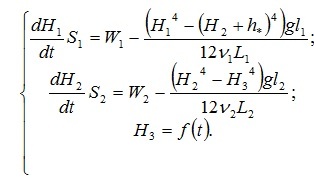 (1)
(1)
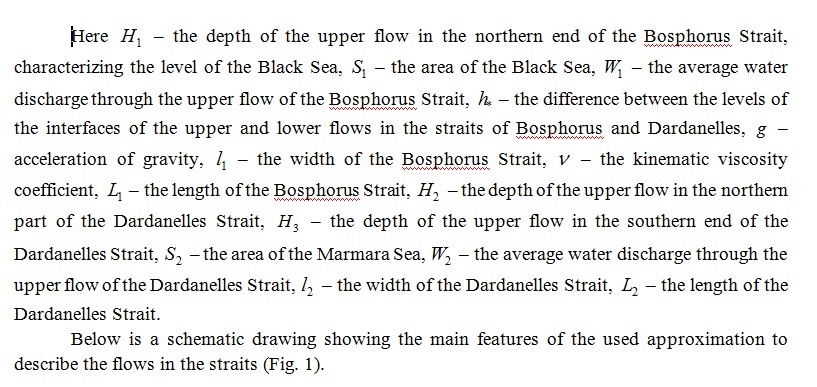
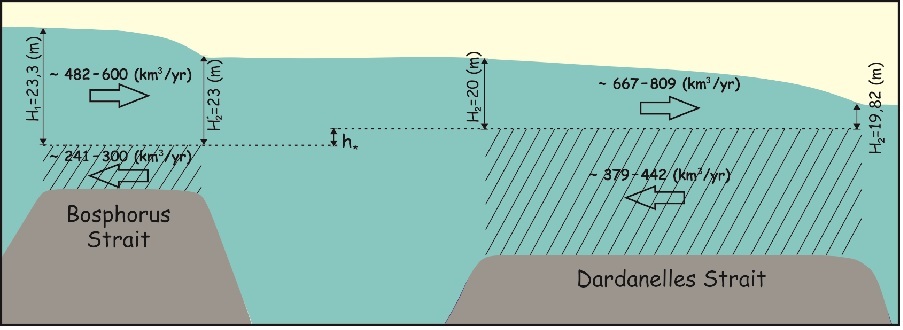
Fig. 1. Scheme of the modeled flows of water in the straits of Bosphorus and Dardanelles
Current average annual water discharge through the upper flow of the Bosphorus Strait is 482–600 km3/year [2; 8]. Theoretical calculations Oguz et al. [11] and field observations Jarosz et al. [6] have shown that at present in the area of the shallowest part of the Bosphorus Strait, average for year the surface of the counterflow locates at depth of approximately 23 m, i.e. the depth of the upper flow at this point is 23 m and the depth of the lower flow is 13 m. The difference in the average levels of the Black and Marmara seas is 0.3 m [6; 9]. Width of the narrowest section of the Bosphorus Strait is 700 m. These data allow us to determine the value of the coefficient  , at which 15,284 m3/s (482 km3/year) of water would flow in the channel with depth of 23 m, width 700 m and the level difference of 0.3 m, and thus to adapt the model to the concrete conditions.
, at which 15,284 m3/s (482 km3/year) of water would flow in the channel with depth of 23 m, width 700 m and the level difference of 0.3 m, and thus to adapt the model to the concrete conditions.
 . (2)
. (2)
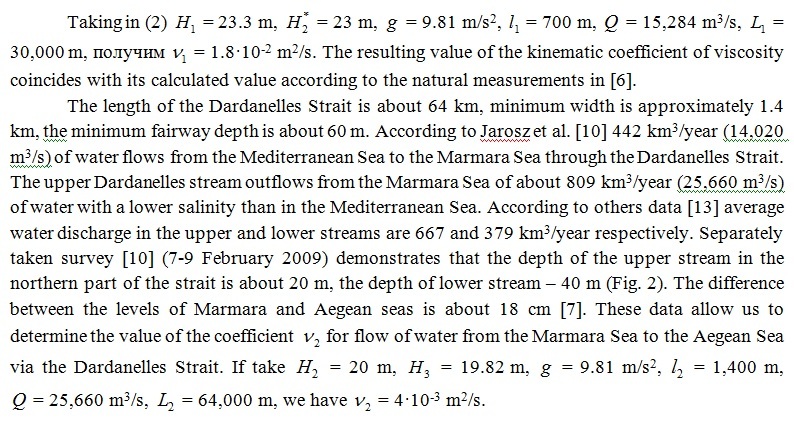
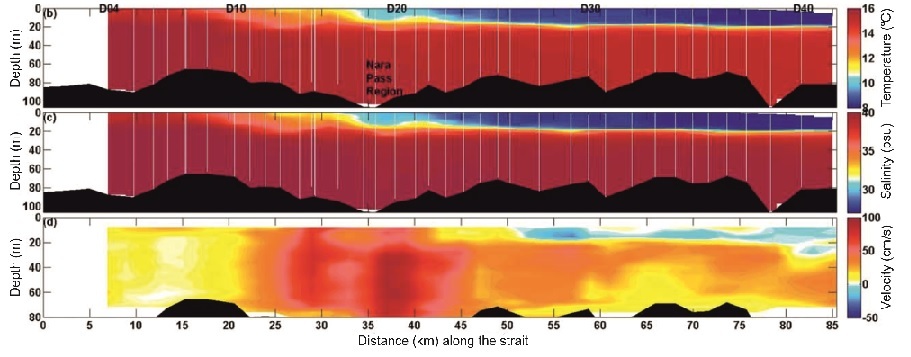
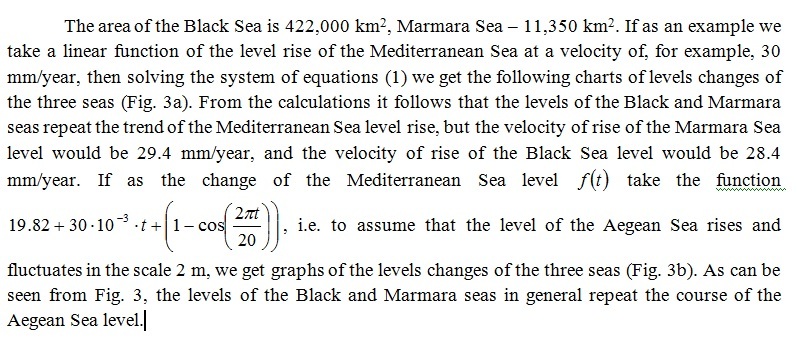
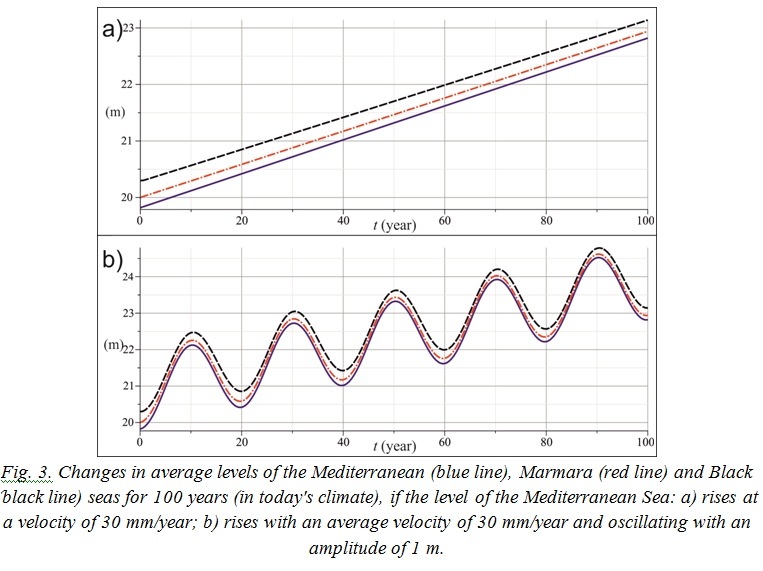
The proposed mathematical model and the curve obtained earlier for the eustatic changes of the Mediterranean Sea level [2; 12] give the possibility to calculate the curve of the Black Sea level change in the last 6,000 years (Fig. 4). The calculations are performed under the assumption that the freshwater balance of the Black Sea during this period of time remained close to the present.
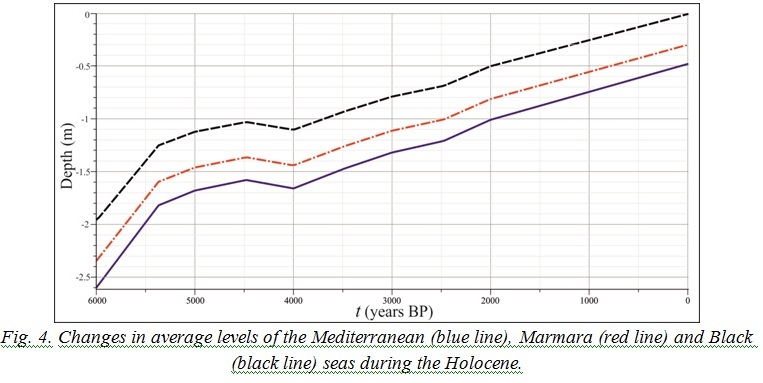
IV. Conclusion
The mathematical model presented in the paper shows that the levels of the Black and Marmara seas depend on the level of the Aegean Sea. In terms of the existence of straits with two-layer flow and a positive freshwater balance of the Black Sea, the levels of the Marmara and Black seas repeat the course of the Aegean Sea level, constantly staying tens of centimeters above the level of the Aegean Sea.
The calculated curves of the levels changes of the Black and Marmara seas (Fig. 4) depend mainly on the shape of the used eustatic curve of the Mediterranean Sea level change. The curve of the eustatic changes of the Mediterranean Sea level was obtained as a result of mathematical processing of a large number of data geological studies on the local changes in the level of the Mediterranean Sea. However, it should be noted that currently it is not possible to get an accurate curve of a sea level in the past. In the construction a curve of the sea level change using the radiocarbon method, the age of sediment is determined with an error of up to 300 years. In addition, to register the position of the dated shoreline in relation to contemporary edge, the material for dating (wood, peat, leaf mollusks, corals) are taken on the ancient border between ocean and land. It's hard to do, as the wood with the coastal sediments can be discarded by the waves above the water line or, alternatively, buried below it (especially in estuaries). Peat deposits are also not accurately fix the position of the basin level. Mollusk of the shell of which can be carried out determination of age, can live at different depths, which is not always possible to determine with sufficient accuracy, in addition, the waves or currents could move its shell to another vertical position.
V. Acknowledgment
The study was funded by RFBR according to the research project № 16-35-00441
1. N.V. Esin, V. Yanko-Hombach, O.N. Kukleva, and N.I. Esin, “Main regularities of the late Pleistocene-Holocene transgression of the Black Sea,” Doklady Earth Sciences, vol. 430, Part 2, DOI:https://doi.org/10.1134/S1028334X10020108, pp. 194-197, 2010.
2. N.I. Esin, Dinamika urovnya Chornogo morya v poslednie 20 tysyach let [Dynamic of the Black Sea level during the last 20,000 years].PhD thesis, PP Shirshov Institute of Oceanology, Russian Academy of Sciences, Moscow, 2014, p. 156 http://www.ocean.ru/disser/index.php/dissertatsii/category/23-esin.html (in Russian).
3. N.V. Esin, and N.I. Esin, “Mathematical modeling of the Black Sea level change for the last 20000 years,” Quaternary International, Elsevier Ltd and INQUA, DOI:https://doi.org/10.1016/j.quaint.2014.05.026, vol. 345, pp. 32-47, 2014.
4. N.V. Esin, V. Yanko-Hombach, and O.N. Kukleva, “Mathematical model of the Late Pleistocene and Holocene transgressions of the Black Sea,” Quaternary International, Elsevier Ltd and INQUA, DOI:https://doi.org/10.1016/j.quaint.2009.11.014, vol. 225, pp. 180-190, 2010.
5. N.V. Esin, N.I. Esin, and V. Yanko-Hombach, “The Black Sea basin filling by the Mediterranean salt water during the Holocene,” Quaternary International, Elsevier Ltd and INQUA, DOI:https://doi.org/10.1016/j.quaint.2015.05.011, in press.
6. E. Jarosz, W.J. Teague, J.W. Book, and Ş. Beşiktepe, “On flow variability in the Bosphorus Strait,” Journal of Geophysical Research, vol. 38, issue 21, pp. 116-124, 2011..
7. B. Alpar, and H. Yuce, “Sea-level variations and their interactions between the Black Sea and Agean Sea,” Estuarine, Coastal and Shelf Science, vol. 46, pp. 609-619, 1998.
8. Ş. Beşiktepe, H.İ. Sur, E. Özsoy, M.A. Latif, T. Oğuz, and Ü. Ünlüata, “The circulation and hydrography of the Marmara Sea,” Progress In Oceanography, vol. 34, issue 4, DOI:https://doi.org/10.1016/0079-6611(94)90018-3, pp. 285-334, 1994.
9. R.N. Hiscott, A.E. Aksu, P.J. Mudie, M.A. Kaminski, T. Abrajano, D. Yaśar, and A. Rochon, “The Marmara Sea Gateway since ∼16 ky BP: Non-catastrophic causes of paleoceanographic events in the Black Sea at 8.4 and 7.15 ky BP,” in The Black Sea Flood Question: Changes in Coastline, Climate, and Human Settlement, V. Yanko-Hombach, A.S. Gilbert, N. Panin and P.M. Dolukhanov, Eds. Springer Netherlandsa, DOI:https://doi.org/10.1007/978-1-4020-5302-3_5, 2007, pp. 89-117.
10. E. Jarosz, W.J. Teague, J.W. Book, and Ş. Beşiktepe, “Observed volume fluxes and mixing in the Dardanelles Strait,” Journal of Geophysical Research: Oceans, vol. 118, pp. 5007-5021, 2013.
11. T. Oğuz, E. Özsoy, M.A. Latif, H.İ. Sur, and Ü. Ünlüata, “Modeling of Hydraulically Controlled Exchange in the Bosporus Strait,” Journal of Physical Oceanography, vol. 20, № 7, pp. 945-965, 1990.
12. N.V. Esin, and N.I. Esin, “Change in the Level of the World Ocean in the Holocene,” Doklady Earth Sciences, vol. 448, part 1, DOI:https://doi.org/10.1134/S1028334X12120082, pp. 135-137, 2013.
13. Y. Kanarska, and V. Maderich, “Modelling of seasonal exchange flows through the Dardanelles Strait,” Estuarine, Coastal and Shelf Science, vol. 79, issue 3, DOI:https://doi.org/10.1016/j.ecss.2008.04.019, pp. 449-458, 2008.







